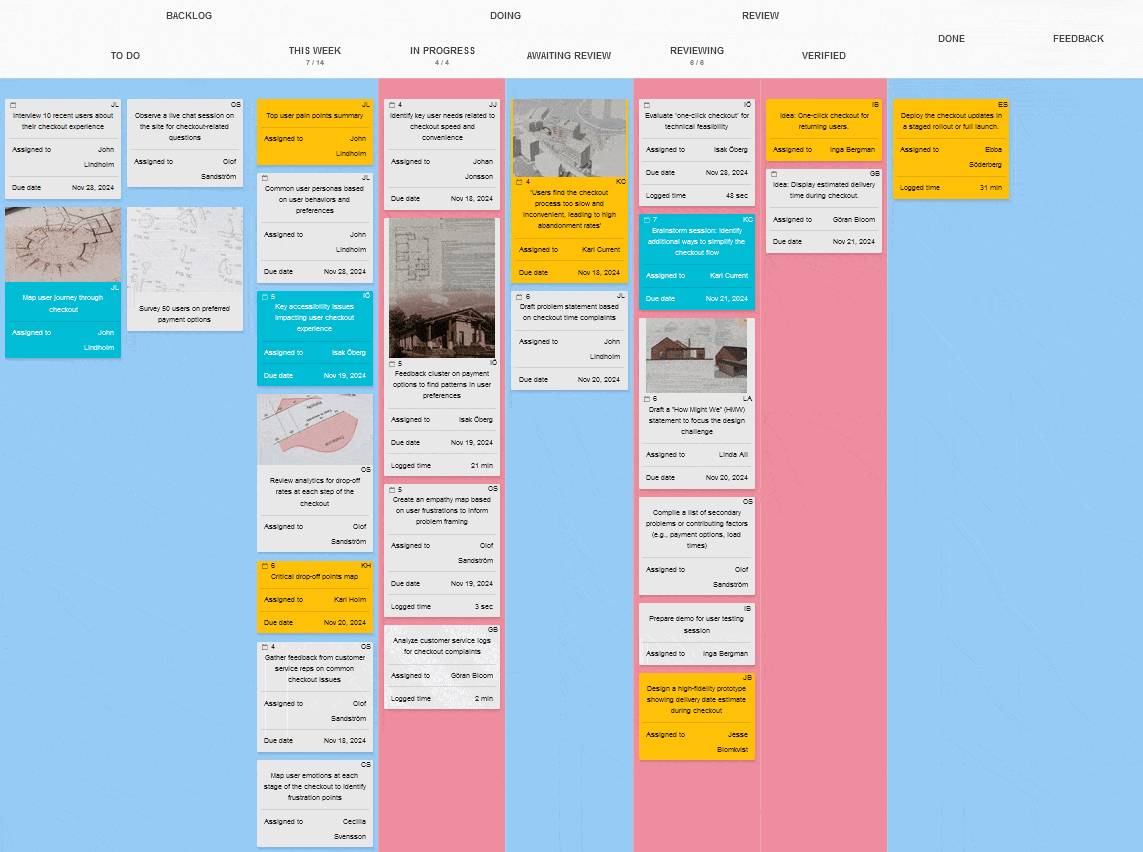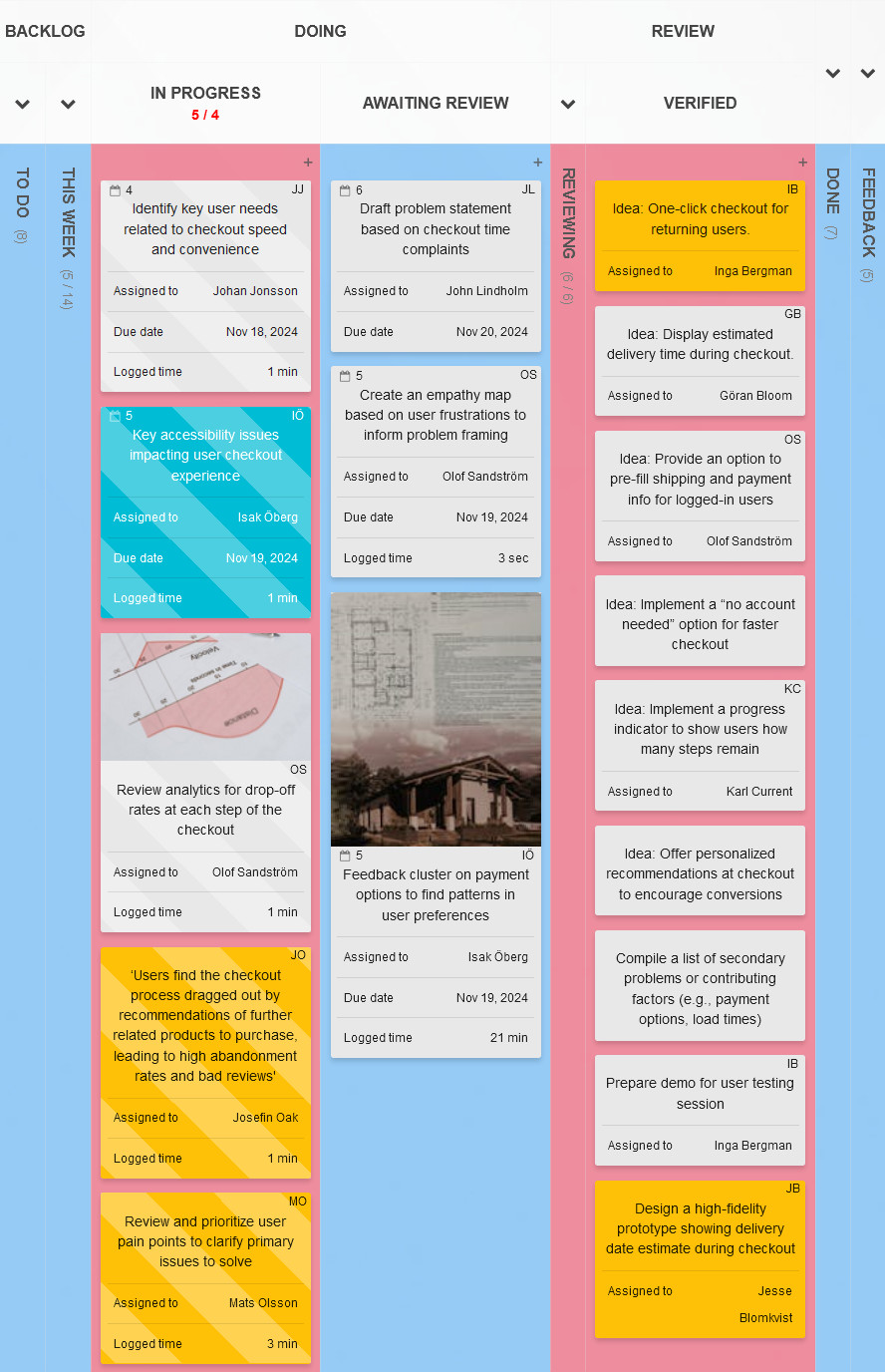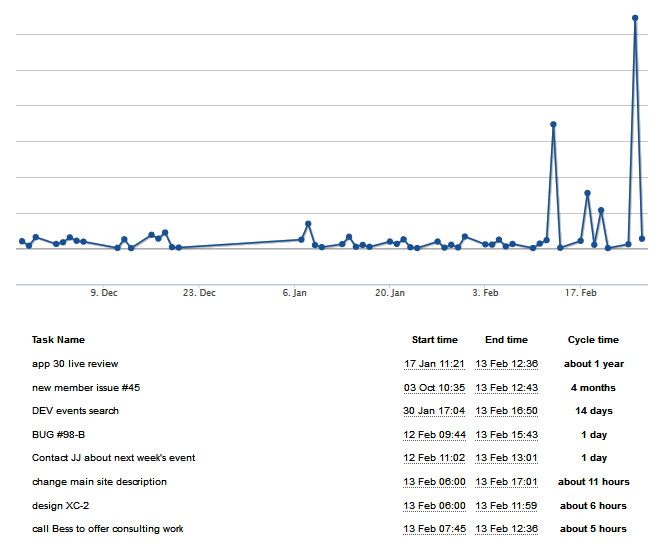Blog
Kanban Boards for Innovation - Fueling Creativity and Collaboration with Visual Project Management14 Nov 2024

When managing innovative projects, the focus shouldn't be just on completing tasks — but also on sparking creativity, fuelling collaboration, and allowing for flexible pivots. It can be tricky to balance. While innovation demands structure, it should not be the kind that stifles imagination and spontaneity. Here is where a Kanban board - a deceptively simple tool - can be transformative for innovative work. With visual workflows, limited work-in-progress columns, and informative process metrics, Kanban boards help teams manage tasks while staying agile enough to embrace creative ideas and spontaneous experimentation. Let's take a closer look at how Kanban boards help innovation thrive.
1. Visualizing the workflow

A Kanban board illustrates each phase of a project, typically with columns representing process steps such as To Do, In Progress, and Done. That provides a clear and intuitive roadmap that everyone on the team can understand at a glance. This transparency reduces the cognitive load on team members, freeing up mental space to focus on creative solutions instead of keeping track of to-dos in their heads.
A visual workflow is also excellent for highlighting potential bottlenecks early on. When one stage of the project has too many tasks piling up, the team sees it and can take action before a blockage hinders their productivity. It's highly beneficial for innovation projects, since different phases may need varied approaches and timeframes; and learning how tasks flow through each stage helps the team adapt and stay fluid.
Moreover, when each task has its movable card representation, rearranging or reprioritizing based on new ideas or emerging needs becomes very easy. For instance, if an unexpected opportunity to experiment with a new technology arises, it’s as simple as adding a new card or reordering existing ones to accommodate that pivot without disrupting the overall project plan.
2. Limiting work in progress
In a traditional project management setup, it’s common to see team members overloaded with tasks, which hinders their ability to experiment or explore. The Kanban method's insistence on constraining work-in-progress (WIP) can counter this tendency. By restricting the number of active tasks, WIP limits help ensure that team members aren’t spread too thin, thus making room for spontaneous, creative work between structured tasks.

WIP limiting is particularly advantageous for innovative work, where creative ideas can often emerge suddenly. Let’s say a team is planning a product enhancement, but halfway through, they stumble upon a new, potentially groundbreaking application. With WIP limits in place, they’re better equipped to set aside time to experiment with the new idea without derailing the original plan.
Additionally, WIP limits support a healthier workload, potentially resulting in less burnout and a more sustainably creative environment. Instead of rushing through tasks, the team has the mental bandwidth to delve deeper, explore new angles, and take calculated risks — all crucial components of the innovation process.
3. Encouraging collaboration
It's rare for true innovation to be a solo endeavor; it thrives in collaborative environments. Kanban boards support teamwork by making it easy for everyone to see what others are working on, where bottlenecks crop up, and how they can contribute. Typically, each card on a Kanban board is assigned to a specific individual or team, yet everyone can see what others are working on, encouraging cross-functional support and collaboration.
During innovative work, where experimentation and idea-sharing are key, this visibility fosters an atmosphere of shared responsibility. For instance, if the design team spots a potential problem in a development task, they can proactively offer their input or suggest changes. A collaborative spirit often leads to a richer pool of ideas, as teams aren’t working in silos, but rather in an integrated, cross-functional flow.

What's more, Kanban boards allow for open discussions around process improvements. When the team members regularly review the board together, they’re encouraged to share insights and brainstorm ways to make the process more effective — thus driving continuous improvement and a more creative approach to solving problems.
4. Data-driven creativity
Although creativity might seem incompatible with data, metrics such as the Lead and Cycle Time can empower innovation by providing insights into the project’s pace and efficiency. Lead time measures the duration from when a task is first added to the board until its completion, and cycle time measures how long a task takes once it’s actively being worked on.

Tracking these metrics over time allows teams to identify patterns in their creative process. For instance, particularly long lead times for certain types of tasks might indicate that this work type faces unnecessary delays, prompting a deeper dive to uncover the cause. Cycle time metrics, on the other hand, can help the team assess how quickly they are iterating on ideas and implementing new insights. Are some experimental tasks moving through the board faster than others? That could be a clue as to which ideas are the easiest to develop — or, conversely, which might benefit from additional exploration.
Data-driven insights also allow the team to evaluate the innovation project's success. If a new approach consistently shortens lead times without sacrificing quality, for example, the team can confidently apply that approach to future projects, knowing it encourages a smoother flow of ideas.
5. Built-in flexibility
Innovation projects are rarely linear - they typically require constant iteration based on feedback and testing. Kanban boards accommodate this need for flexibility by allowing tasks to move freely between stages. If an experiment requires refinement, the task can just be moved back to the In Progress column or even back to the To Do list for additional work. This ease of movement encourages a mindset that values refinement and quality over rigid timelines.
Kanban boards lend themselves well to regular review cycles, such as daily stand-ups or weekly retrospectives. These check-ins are crucial in innovation projects, where team members can review what’s working, and what isn’t, brainstorming adjustments in real time. This feedback loop allows for continuous learning so teams can pivot and refine ideas quickly and efficiently without the burden of extensive documentation, re-planning, and additional approvals.
6. Customization all round
One of the greatest strengths of Kanban is its adaptability. Teams can customize Kanban boards to fit their unique needs. For instance, rather than a standard three-column board, they might add additional columns such as Ideation, Prototyping, Testing, and Refinement to capture the specific stages of their innovation process. Such customization ensures that every project phase has its own space, reducing confusion and helping team members stay focused on the task at hand.

Color coding, labels, custom icons, and priority markers can further enrich the board, making it easy to identify work items that are particularly time-sensitive or high-impact. Such tailoring helps align the team’s efforts with the project’s broader goals, ensuring that innovation projects stay true to their purpose while still being agile.
Driving innovation with Kanban’s structure and flexibility balance
Kanban boards provide an ideal framework for managing innovation projects, blending the structure needed to stay organized with the flexibility necessary to foster creativity and exploration. By visualizing workflows, using WIP limits, encouraging collaboration, tracking performance metrics, and allowing for custom process design, Kanban boards become more than just a task management tool — they become a canvas for creative innovation.

The ability to innovate quickly and efficiently can differentiate industry leaders and followers. Kanban’s adaptable structure offers a robust yet agile way to manage this delicate balance, giving teams the clarity, space, and support they need to turn bold ideas into successful, impactful projects.
Sign up for a 14-day free trial
to test all the features.
Sign up now and see how we can help
your organization deliver exceptional results.